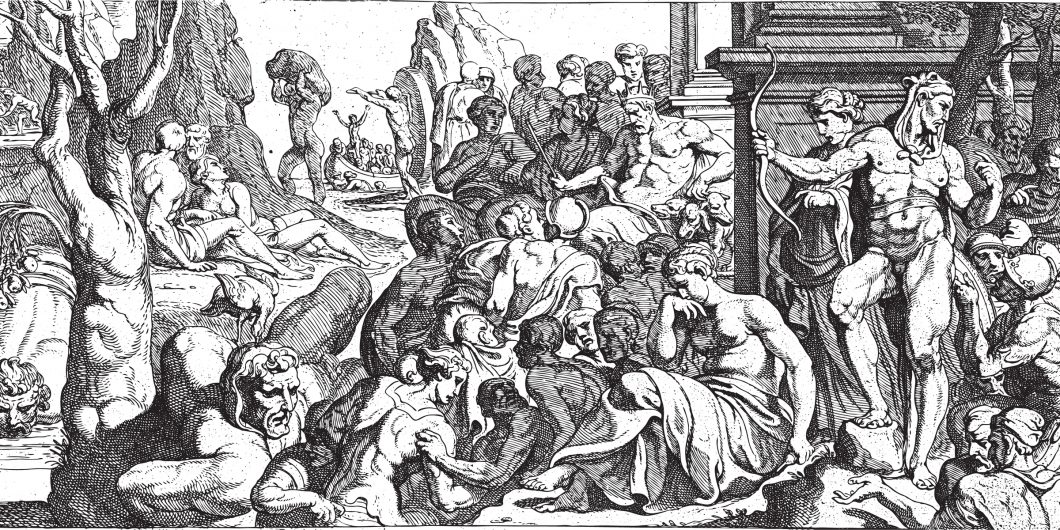There is plenty of risk and uncertainty that might give rise to our next financial crisis.
Odysseus’ New Birth of Freedom
“Rage, goddess, sing the rage of Peleus’ son Achilles / and its devastation . . .” The first few times I read Homer’s Iliad, which begins with these famous words, I have to confess I did not quite grasp the significance of Achilles’ rage. It all seemed so childish and petty: a young man at the top of his game, put out because a superior has taken his war prize, decides to sit out the conflict and make his own side feel the absence painfully. Surely this is little better than a schoolyard narrative: how could it be the stuff of epic poetry? But with further life experience—work, marriage, children, finances, politics, and so on—let us admit that Achilles’ anger becomes more intelligible. Indeed, it is all around us.
Here is the opening salvo of Nalin Ranasinghe’s new Confessions of Odysseus, now (alas) posthumously published: we Americans are living in a new age of Achilles, defined centrally by the phenomenon of rage (Greek, mênis) that is culturally fostered and spread throughout all sectors of our political and social order. Ranasinghe wrote this book, the last of his too-brief career, to argue that Homer’s Odyssey can provide us with much-needed wisdom about how to escape our current predicament. “Only Odysseus,” he says, “can redeem us from Achilles and set the cycle of civilization in motion again.” What can such a claim mean? A great deal, as it turns out, but in order to understand Ranasinghe’s illuminating argument about the Odyssey, we will need first to think about his description of the Iliad.
How do You Solve a Problem Like Achilles?
The Trojan War, for Ranasinghe, is an appalling spectacle of moral and political disorder. We can break the problem down into three parts: unjust authority, unhinged rage, and technological enabling. The unjust authority, as Ranasinghe sees it, is everywhere among the men and gods of the Iliad: Agamemnon, high king of the Greeks, does not deserve his position and abuses it to no end—indeed, the epic begins with one such injustice. But Achilles, Odysseus, and the other kings allied with him are also abusing their power, ruining not only the cities, families, and individual lives all around them through slaughter and pillage, but their own political and family cultures back home, where no one is around to rule. The gods of the Iliad are no better, according to Ranasinghe, for their rule is also arbitrary, unmerited, and heedlessly unjust.
The corruption of this system, represented by Agamemnon, is what causes the younger but stronger man Achilles to erupt in fury: here, Achilles thinks, is a scoundrel who wants special treatment, and doesn’t deserve it—but can force those under him to offer it. He viscerally feels the injustice of Agamemnon and the whole system, and reacts against it in rage, deciding to bench himself for the rest of the war, even though—or especially because—it hurts his side. Of course, his anger at wrongdoing leads him into his own injustice: he objects to Agamemnon, but only seeks the same kind of crude, violent, dominating power himself. They both in the end want the same thing: to play the role of Zeus among their fellow mortals.
The last facet of Ranasinghe’s description is the technological enabling of Achilles’ rage by Hephaestus. The metalworker god on Mount Olympus, at the behest of Achilles’ goddess mother, fashions godlike armor to defend the young hero when he finally returns to battle. For Ranasinghe, this technological aid is symbolic of all the artificial enabling that has supported Achilles from on high throughout the story: through divine artifice, he has received his position as king, his near-invincibility on the battlefield, his martial glory, and the luxury of soaking himself in anger and resentment. Achilles can only be Achilles because divine powers have favored him for no clear reason, and enabled him to operate in a state of nearly complete protection.
If all of this sounds fanciful and far off, Ranasinghe assures us that it is not: “Achilles is the starting point of each generation,” he says, in the sense that there is always plenty of arbitrary injustice in any given government (or culture, or workplace, or family), and it is the fate of the young to recoil from it in rage. “The pain of the unrecognized young is potent. Any antisocial angry youth identifies with Achilles,” according to Ranasinghe, “and seeks to fulfill a false nature that destroys the city instead of becoming a political animal realized in it.” If the last two years of American history have not proven the spot-on accuracy of this judgment, nothing can. But carrying the point further, Ranasinghe adds that we too have technologically enhanced our Achillean rage, in at least two ways: first, we have developed social media for the special purpose of extending and magnifying our madness. And second, we have lionized youth to the extent that all ages now strive to participate technologically in the anger of the young: “today technology has created a world where everyone from 8 to 80 strives to be Achilles at 18.” The Iliad’s dramatization of a civilization-ending culture of injustice and wrath is thus a myth for our time.
The Odyssean Antidote
Thankfully, then, Homer also wrote the Odyssey for such an age as this. If the Iliad is a “tragedy describing the perennial temptations inherited by every generation,” the Odyssey is a true epic, “prescribing how these psychic diseases are cured.” The majority of Ranasinghe’s work is a book-by-book commentary on Homer’s second poem, not crabbed and scholarly but free and fluent. He divides the epic into six parts (Books 1-4, 5-8, 9-12, 13-16, 17-20, and 21-24), but for the sake of time, we may split his treatment in two: the part covering the voyage home (Books 1-12 of the Odyssey), and the part dealing with Odysseus’ actual arrival (Books 13-24).
Ranasinghe’s brilliant account of Odysseus’ ten-year journey toward home turns on the basic idea that the hero’s most famous narration of the voyage is not literally true. Just before getting home, Odysseus stays for a short time with a people called the Phaiakians, and it is to them that he tells the best-known story of his departure from Troy, followed by an immediate stop to raid and sack an unwitting city of so-called Kikones. Odysseus and company are successful, but then fail to avoid a deadly counterattack which overtakes them while they feast drunkenly on the beach. From there, Odysseus tells of meeting and escaping the Lotus-eaters, and of the famous encounter with the Cyclops, where Odysseus and a few picked men are trapped in the monster’s cave, and several are eaten before they manage to blind the creature and get away. The other major episodes in Odysseus’ narrative are the tragic meeting with the Laestrygonian giants (nearly all Odysseus’ men die), the one-year stay with the witch-goddess Circe, the descent to meet the shades of the dead in the Underworld, the stop on the Island inhabited by the sun-god’s oxen, and the final, seven-year stay Odysseus is forced to make, alone, with the goddess Calypso.
His return, then, is founded on love, a concern for real justice, and a healthier relation to the divine. He has come home to his true humanity and begins working toward a new, better civilization, one Ranasinghe sees heading toward Athenian-style democracy.
Intriguingly, Ranasinghe interprets these narratives as “a vivid series of lies,” Odysseus’ “visual account of himself, clothed in spatial-temporal terms, that seems to explain what befell him since the Trojan War,” but is in fact truer as a moral and psychological myth than a literal representation. That is, what the narrative to the Phaiakians really communicates is the set of pathologies that kept Odysseus away from home for so long. In at least three of the stories, Ranasinghe points out, Odysseus goes down into a cave for a time, and of course the Underworld account is also a cave-like experience: “what is depicted here,” in each of these stories, “is the first descent made by a man into the depths of his soul.” As in Plato’s Republic, Odysseus’ mythic self is caught in cave after cave, all of which represent the same cave in some sense—the cave of his own moral and psychological blindness. In the figure of the cyclops, therefore, Odysseus himself is the enemy he confronts. He is more a cyclops than he feels like admitting straightforwardly: violent, lawless, fixated on the present, sacrificing his men for his own consumption. “By blinding himself through his violent hubris,” he has himself become a kind of cyclops, “a monstrously uncanny source of trouble and terror to comrade and enemy alike.” The Circe and Calypso episodes can also be read as parallel myths trying to get at the same awful truth: that Odysseus has been imprisoned, not by tropical island sex goddesses, but by his own blind habits of reckless consumption, careless of the cost to himself or others. Odysseus is still more like the Iliad’sAgamemnon or Achilles than anything else.
This is the fruit of the Trojan War, and Odysseus only escapes it through tremendous suffering. Whatever really happened to Odysseus during his ten-year return journey—and Ranasinghe stresses that we will never fully know—it punished him with his own vices, bringing him to self-knowledge, and a humble admission of his need for divine help. The second half of the Odyssey Ranasinghe reads as Odysseus’ return to himself and his people, now that ten years’ suffering has zeroed out his cyclopean barbarity. The goddess Athena, alienated during his years of transgression, now comes back into his life, and he becomes capable of relying on her once again. He returns to his homeland, Ithaca, as a nobody—a filthy beggar—and takes his place by telling the truth (or something closer to it) about his depraved years. It is a confession of sin to another nobody, his swineherd Eumaeus. He next comes into league with his son Telemachus, and tacitly, his wife Penelope: together, they scheme to rid their house of the suitors who, like soldiers in the Iliad, have been pillaging the estate. His return, then, is founded on love, a concern for real justice, and a healthier relation to the divine. He has come home to his true humanity and begins working toward a new, better civilization, one Ranasinghe sees heading toward Athenian-style democracy. By confronting and confessing our own Achillean, cyclopean weakness, we too may experience a new birth of freedom.
Here is the central claim of The Confessions of Odysseus. Does Nalin Ranasinghe successfully defend it? The answer is far more yes than no. While there are a number of interpretive stretches (along with an embarrassment of typos), Ranasinghe’s panoptic vision of the Homeric poems, and his dizzying mind for cross-textual connections, really command our respect, even when we cannot follow him all the way. Ranasinghe also places Homer in direct conversation, not just with Plato, but Aristotle, Jesus, Augustine, Machiavelli, and Nietzsche, among others: the whole tradition, and the whole of life, is bound up in every scene. His reading, though, is especially—and attractively—Platonic, emphasizing the centrality of self-knowledge, the emergence from the cave of culturally fostered opinion, the knowledge of one’s ignorance, and the tilt of the cosmos toward virtue. “Homer,” as he says, “has done most of the work . . . . Socrates and Plato only retrieved what was implicit in his texts.”
This book comes to us as a posthumous gift from one who loved the text and sought to wrestle with it, like Jacob, for life. The Confessions of Odysseus will change how I read and teach Homer, and give us all fresh approaches to our suffering lives and strife-ridden culture.



